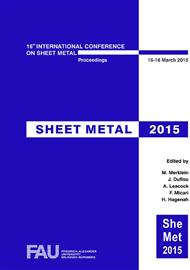p.155
p.163
p.173
p.179
p.187
p.195
p.205
p.213
p.221
Experimental Testing of an Analytical Model for Membrane Strains in Single Point Incremental Forming
Abstract:
Single Point Incremental Forming (SPIF) is a method of forming sheet metal components that requires only minimal tooling and a standard 3 axis milling machine. The low tooling and setup costs of SPIF make it an ideal method for prototyping and low-volume manufacturing. One of the challenges of SPIF is the development of tool paths that will form parts successfully, without encountering failure modes such as fracture due to wall thinning. To progress beyond a trial and error approach to tool path creation, an accurate and fast method of predicting failure must be developed. Forming limits in SPIF are often characterised by a maximum wall angle, corresponding to thinning limits according to the sine law [1]. While inexpensive computationally, the sine law does not account for secondary strains due to part curvature, and is not applicable to multi-pass forming [2]. A more general method of rapidly predicting wall thinning and strain state of a post-formed part is necessary. One such method is a kinematic model proposed by Bambach (2010) [3] which simulates the displacement of the model during each pass of the tool relying only on geometrical data.In this paper, the kinematic model mentioned above is extended to be applied to multi-pass forming and experimentally tested by comparing model predictions of major and minor strains to experimental measurement. The model is found to accurately predict minor strains during multi-pass forming, while over-predicting major strains, likely due to material property and friction affects unaccounted for in the model. By properly understanding the accuracy and limitations of this model as applied to real forming conditions, toolpath strategies can be generated in future with confidence and with minimal computation time.
Info:
Periodical:
Pages:
187-194
Citation:
Online since:
March 2015
Authors:
Keywords:
Price:
Сopyright:
© 2015 Trans Tech Publications Ltd. All Rights Reserved
Share:
Citation:


